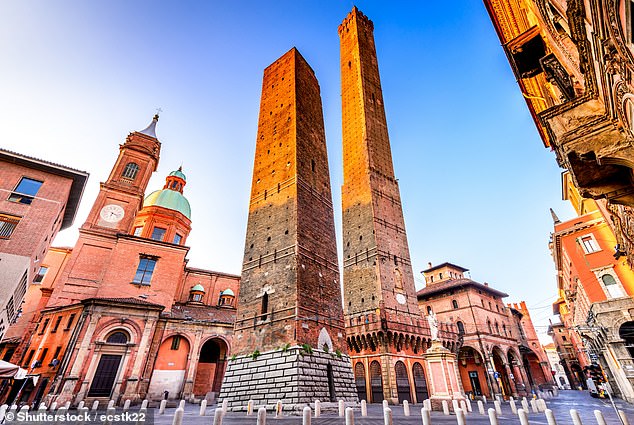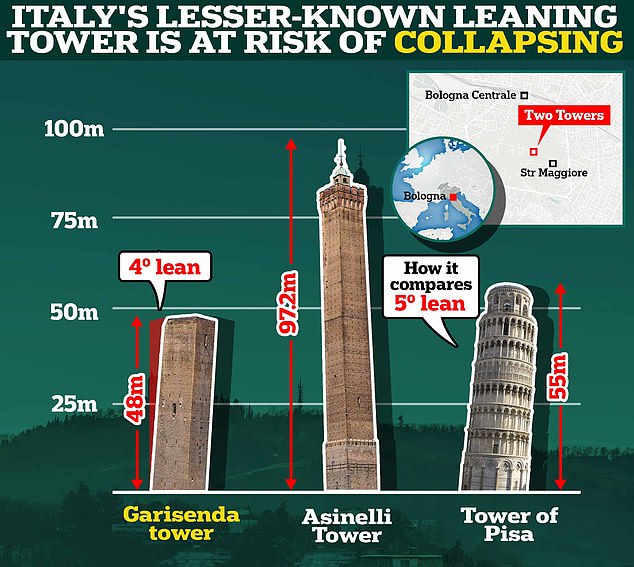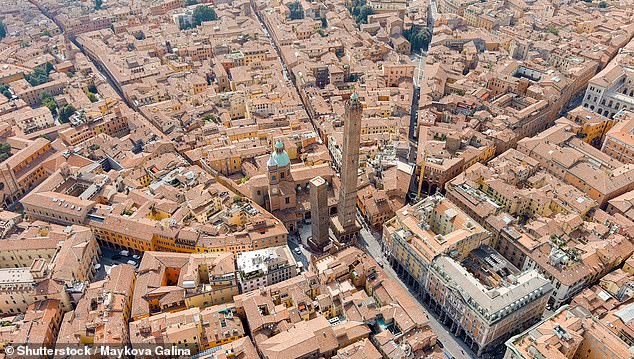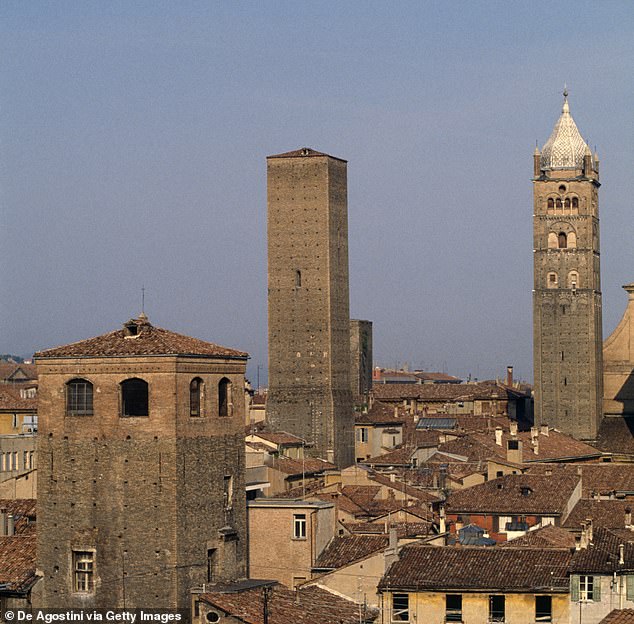Italy’s lesser-known leaning tower is at risk of COLLAPSING: Area around Bologna’s Garisenda Tower is closed after scientists detect unusual movement in the stonework
>
It may not be the most famous leaning tower in Italy, but the Garicinda Tower has now caught the attention of the entire country as scientists have found it is in danger of collapsing.
Scientists from the University of Bologna used ultra-sensitive microphones to pick up any crackling sounds in the tower.
Now, the streets around the 900-year-old Bologna Tower have been closed, after sensors picked up unusual shifts in the stonework.
The Garicinda Tower is 157 feet tall, and has a tilt of four degrees – just less than the famous five-degree tilt of the Leaning Tower of Pisa.
Experts suggest that the tower’s weak foundations may be collapsing, requiring the injection of filler material to add more stability.

The area around the Garicinda Tower has been closed to traffic after abnormal oscillations and noise were discovered coming from the stonework

Bologna’s Garicinda Tower is dwarfed by its neighbour, the Asinelli Tower, and doesn’t quite match the dramatic angle of the more famous Leaning Tower of Pisa
A representative of the Bologna Tourism Board said that scientists discovered abnormal noises, oscillations, vibrations and movements of a few millimeters inside the tower.
They add that traffic restrictions will allow detection equipment to make more accurate recordings before sending specialists to climb the tower to make more accurate measurements.
“Given the cultural importance of the Garicenda Tower, its virtual loss would be tragic, not only in tourism terms but for Bologna and Italy’s history as well,” the spokesman said.
He added: “Fortunately, the signals discovered so far do not lead us to believe that the tower may collapse. The situation is under control and a team of experts is taking care of it properly.”
Italian Culture Undersecretary Lucia Borgonzoni said the situation was worrying and seemed to blame the city council for allowing the danger to develop.
“The situation may have been underestimated by the municipal scientific committee responsible for preserving the tower,” Ms. Borgonzoni said. In an interview with Quotidiano Nazionale.
She added: “The government moved to save the famous Bologna Tower after the city council wasted time.”

One of Bologna’s last remaining medieval towers, the tower was poorly constructed and was considered in danger of collapse as early as 1350.
Ms Borgonzoni also announced that the government would fund work to strengthen the tower using around €5m (£4.3m) from Italy’s EU National Recovery Fund.
The Garicenda Tower was built between 1109 and 1119 by one of Bologna’s rival families who built increasingly tall towers as a sign of their wealth and power.
At the height of the building frenzy, Bologna boasted up to 200 towers of various sizes which were used as defensive structures as well as to signal in times of danger.
However, during major reconstruction works in the 1920s, many of the towers were flattened, and only a few remain standing today.
It is one of the city’s two famous “towers,” dwarfed by the neighboring Asinelli Tower, which nearly doubles its height at 318 feet (97 metres).
Unlike its taller neighbour, the Garicinda Tower was in danger of collapsing almost from the moment it was completed.
In the 13th century, the Italian poet Dante noticed that the tower had declined significantly and by 1350 the 32-foot (10 m) top had to be removed to prevent it from collapsing.

The city’s tourism board says the tower is unlikely to collapse at the moment, but specialist teams have been brought in to make assessments on the necessary conservation measures.
Like most medieval towers in Bologna, the Garicinda Tower was built on a circular base of clay bricks and river stones.
This base material is the likely cause of the steep leaning of the tower as the foundation sinks into the soft Bologna ground.
Nunziante Squiglia, an expert at the University of Pisa, says that both Pisa and Bologna share a similar problem, which is poor land conditions designated for construction.
“Like Pisa, Bologna was built on a plain, and there is a problem with the soft clay soil,” Mr. Squillia said. times.
The properties of this soft clay, combined with the poor construction of the tower’s foundation, caused the Garicinda to sink into the ground and lean to one side.
Others blame the City Council’s decision to allow traffic around the base of the tower, claiming that vibrations from passing vehicles may have further destabilized the foundations.
“We’ve been saying the area should be pedestrianized for years,” Rafael Milani, head of Bologna’s Italian heritage group Italia Nostra, told The Times.
In 2019, the council placed iron bands around the base of the tower, and in 2022 mortar was injected into the foundations.
However, these interventions do not appear to have been successful because the Garisendi Tower is now more at risk of collapse than ever before.
(tags for translation) Daily Mail
